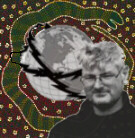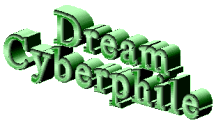Dream Sharing In Cyberspace Continues
Updates, Events and Horizons
For some time we have been relying on the generosity of Grant McEwan College to host
our Web site. But we really need our own domain so that the site is portable from server
to server. What the heck am I talking about? Find our about our new domain in the UPDATE
section.
Princess Diana dreams online: more mass media or symbolic exchange? The usefulness of
the idea of a collective consciousness or collective unconscious is continually
questioned. But the idea of a public realm is commonly accepted and with the rise of mass
media, there is now a kind of global public sphere. Does the mediation of reality leads to
the interconnectedness of a global village or an isolated existence in a simulated media
event? Read about the sharing of Diana dreams online and how they contribute to this
debate in the EVENTS section.
Have you been wondering where all this Internet and dream stuff is going? So have many
individuals in ASD. Several have decided to develop some long term plans on how to use
this new channel of communication. Jeremy Taylor, Kelly Bulkeley , Roger Ripert and others
have been exploring the possibilities of a Global Dream Congress 2000. The topics will
include dream art, healing and spirituality, among others. You can get involved in this
project now by reading more in the HORIZON section.
UPDATE: www.ASDreams.org
Please note our new ASD Web Address/URL and update your hot lists! We
now have our own Internet domain, www.ASDreams.org (Preferred style)
which can be written or used as above or www.asdreams.org or WWW.ASDREAMS.ORG
Thanks Jayne. Cyber-Dream Titan Jayne Gackenbach will be leaving the
ASD Web management to me, but she will still head the Electronic Committee and is as
active online as ever. Jayne is editing a book on the psychology of the Internet for
Academic Press, preparing a related course for online delivery and contributing a global
brain chapter to a book on consciousness, among other activities. I have put summary on
the Web site of how she brought ASD online, but I would like to briefly thank her here for
designing and giving birth to this project. What is even more amazing was the speed with
which this site was approved, designed and put online in time for the 1996 conference.
Also, thanks to Grant MacEwan College for hosting our site since 1995.
Why the move? 1. We need direct access to our site to quickly upgrade
and modify new pages and programs. 2. We need to be able to move our site around to
various hosts as we please without our address continually changing. On the Internet, each
site has a unique address and host. Ours was www.outreach.org/gmcc/asd/ at Grant MacEwan,
If we had moved the site to another host without having our own domain name, say at
www.yale.edu/asd at Yale, we would lose all the referencing and indexing and links to our
site, or just a bad, leave a trial of "Moved To" links. With our own domain
name, www.ASDreams.org, we can move to whatever host we want without any fuss or complex
technical and index coding. The name will always be ours, independent of our host. We will
have to leave "moved to" links at Grant MacEwan, but that will be the last time.
ASD Web - What's New? For the next year I will mostly be finishing up
the programs Jayne started and implementing some of the ideas she began with various
departments at ASD. These include: 1. Having our gallery art on the main page, a new piece
displayed each month. 2. Working with Dream Time to provide more public material
online. 3. Interfacing with the ASD Journal, providing more material and
developing interactive events between the contributors. 4. Developing a system to allow
people online to shop for our products, such as tapes, conference material and backissues
of publications. If you have more ideas, send them in.
Also, I will be including on the site each month an update in the
section "What's New?". Here you will be able to find out what new interesting
links and dream projects are online, what new material is available and how to get
involved in the ASD online community.
One project I will be developing over the next few years an ASD FAQ
file on dreams and dreaming. FAQ, or frequently asked questions, is the common way sites
on the Net field repetitive questions and offer paths to deeper research and education for
those not familiar with the field or topic in the field. Jayne and I have to respond to
the same questions over and over, what is dreaming, why do we dream, do we dream in color,
what is lucid dreaming, what do I do about nightmares, what does my dream mean, how do I
conduct research on dreaming, and so on. As primary and secondary schools connect, ASD
will be one of the main sources for the first level of response to questions about dreams
and dreaming. We have an excellent beginning with our informational pamphlets and great
channels of education in our publications and conferences. An FAQ file will bridge these
areas, expanding and organizing the information in ways that work for the Internet. Being
an organization that holds such diverse opinions may work in our favor in developing a
fair and multi-disciplined document. It will also allow us to more deeply examine,
communicate and unfold our goals and mission statement.
ASD Online Volunteer Program & Training Offer. Our site has many
areas that could use more personal attention. These include being a host on the
interactive message boards, answering questions on dreaming, designing and re-designing
web pages, interfacing with conferences and a whole host of other activities. If you are
interested in getting involved but just don't know anything about the Internet, I will
teach you. You will get an insiders view of the Net, learn all the tricks of online
communication and even learn how to develop your own web site.
If you have more ideas for ASD online, the Web site or would like to joinig the
volunteer program, drop me a line.
rcwilk@aol.com
EVENTS : Dreams of Princess Diana
The French cultural theorist Jean Baudrillard (1) has suggested we are
living in a era that is less and less real. Borrowing from media theorist Marshall
McLuhan, he observes how we move through more and more events with the help of mass media.
The ancient realities of plague, war, starvation, poverty and even celebration now take
place via the six o'clock news and the National Inquirer. We didn't see the Mars
land-rover land, but many people now think that the simulation of the landing was the real
experience. Thus we shift towards living in representations and simulations of reality.
Baudrillard feels that we have even begun to prefer the simulated hyper-reality and no
longer really care whether it represents something else.
Nowhere is this question of mediated reality more hotly debated than
in Cyberspace, a space that Baudrillard feels just accelerates this process of things
becoming hyper-real. Yet the counter balance to this proliferation of signs is the slower
process of interactive symbolic exchange and personal subject-to-subject interactivity,
which the Internet can also facilitate. During the global frenzy surrounding the death of
Princess Diana, personal interactive exchanges began to emerge online in the background of
the flash of photo shoots. Among the many other interesting cultural objects that we
exchanged, dreams of the event and Diana began to appear.(3) As
William Domhoff has noted, (2) this is really statistically unexpected. Summarizing data
from Calvin Hall, Domhoff tells a story of when Hall was collecting dreams during the
explosion of the first two atomic bombs in Japan. The dreams of the students had no atomic
bombs, but continued to be about personal concerns. Domhoff goes on to say that this
further indicates how deeply personal our involvement really was with Diana.
The exchange of dreams of collective or public events also brings up
the possibility of some very interesting research & self-discovery being conducted via
the Net. Not only are there sociological and anthropological patternings worth exploring,
but also the boundaries of the personal and public, and/or the individual and collective.
In dream groups online, the interpretive tendency is to abstract and make metaphors of
inner famous figures. But with the event still happening around us, there is a pull
towards alternative processing.
One woman (3) noted that she couldn't process her personal grief about Diana due to the
constant bombardment of news media events, which she couldn't resist watching. Whether one
is interested in healing and psychotherapy or exploring dream sharing for self discovery
and enhancement, the realm of mediated public-private experience will be a growing concern
for you. Just exactly what roles the dream can play in this new public sphere is not yet
clear, but summarizing from the experience of the online dream sharing community, I can
say that dreams seemed to function in slow down the media bombardment and allow time for
more in depth processing. Perhaps the cultural negligence of dreams (it's just a dream)
has served to fashion dreams as a cultural object that resists commodification &
obvious use value, allowing them to function in another realm. Even if this is going to
far in speculative theorizing, it is at least clear to me that talking about dreams of
current events helps me to slow down the effect of the media blitz. And also, that this
dream exchange could not have taken place before the Net. Like most of our inventions and
technology, more comes through the door we open than first planned. My hope is that more
dream researchers will begin exploring the processing of public events via dream sharing.
HORIZON Planetary Dreaming
In preparation for the 2000 Dream Congress and the Alcheringa (a
series of five planetary dreams which will lead us in the aboriginal Australian land in
the year 2000) Roger Ripert and The French Magazine Oniros continue to sponsor
online planning and events.
For example, the first planetary dream event was a globally incubated
dream theme. The planetary dream was made up with all the dreams the participants have had
during the 1996 winter solstice's night. Those dreams were inspired by a theme:
"Dream and Law" which was distributed around the world to the participants. The
dreams were released on a web site with summaries and associations by participants.
http://perso.club-internet.fr/oniros/dreams96.htm
These and other focus programs will continue through the year 2000, providing support
and direction for the Global Dream Congress.
Meetings on Internet, via the IRC program (Internet Relay Chat)are
usually on the network FR.Undernet.org or the Undernet server. For more information, email
oniros@club-internet.fr or by postal mail : Oniros, BP 30, 93451 Ile Saint-Denis, France.
Oniros Web: http://perso.club-internet.fr/oniros/index.htm EASD Web:
http://perso.club-internet.fr/oniros/EASD/
Bibliography
1. Baudrillard, Jean (1983). Simulations. Translated by Paul Foss, Paul Patton
& Philip Beitchman. New York, NY: Semiotext(e).
2. Domhoff, William G. (1997). Dream Content Analysis Princess Diana: A Phone Interview
conducted by Richard Wilkerson , September 26, 1997. See the updated content analysis web
site and DreamSAT spreadsheet at http://zzyx.ucsc.edu/~dreams/
3. Wilkerson, Richard C. (1997 -Sep). Dreams And Princess Diana. A collection of dreams
and articles on Princess Diana. Electric Dreams, volume 4 issue 9
<www.dreamgate.com/dream/ed-backissues/ed4-9.htm> (Sept 29, 1997).


 Return to ASD HOMEPAGE
Return to ASD HOMEPAGE